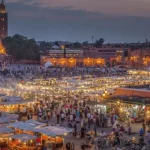Imagine embarking on a winter journey to the mystical land of Cambodia, a country steeped in ancient history and vibrant culture. Your adventure begins in the town of Siem Reap, the gateway to the awe-inspiring Angkor Wat.
As you arrive in Siem Reap, you are immediately enchanted by the warm smiles of the locals and the bustling atmosphere of the town. The air is filled with the tantalizing aroma of street food, and the vibrant colors of traditional Khmer textiles catch your eye. Siem Reap serves as a perfect base for exploring the wonders of the Angkor Archaeological Park.
The heart of your exploration lies in the magnificent Angkor Wat, a colossal temple complex that whispers tales of the Khmer Empire’s golden era. The intricate carvings and towering spires transport you back in time to the 12th century when King Suryavarman II envisioned this grand tribute to the Hindu god Vishnu. Later, it transformed into a Buddhist sanctuary, embodying the cultural synthesis that defines Cambodia.
Wandering through the sprawling complex, you’re captivated by the bas-reliefs depicting epic scenes from Hindu mythology. Each stone seems to tell a story of devotion, power, and artistic brilliance. As you climb the steep steps to the upper terraces, Angkor Wat reveals itself in all its glory—the iconic silhouette against the backdrop of the Cambodian sky is a sight to behold.
Venturing beyond Angkor Wat, you explore the labyrinthine temples within the Angkor Archaeological Park. Ta Prohm, with its ancient trees embracing the ruins, feels like a journey into a lost world, frozen in time. The faces of Bayon, adorned with enigmatic smiles, beckon you to unravel the mysteries of the past.
In Siem Reap, the evenings are as enchanting as the days. The vibrant Night Market beckons with its array of handmade crafts, textiles, and local delicacies. You find yourself immersed in the rhythmic beats of traditional Apsara dance performances, a cultural treasure that adds a touch of elegance to your evenings.
As you delve into Cambodia’s rich culture, you make your way to the capital, Phnom Penh. Here, the Royal Palace stands as a testament to the country’s regal history, and the Tuol Sleng Genocide Museum and Killing Fields serve as poignant reminders of Cambodia’s tumultuous recent past.
On your journey, you savor the flavors of Cambodian cuisine—delicate fish amok, flavorful Lok Lak, and the refreshing taste of coconut milk in every dish. The warmth of the people, the richness of the culture, and the splendor of the ancient temples create an unforgettable tapestry of experiences.
In the winter sunshine, Cambodia unfolds its wonders—a tapestry woven with the threads of history, spirituality, and the resilience of a people. As you bid farewell to this enchanting land, you carry with you not just memories but a deep appreciation for the timeless beauty that is Cambodia.
Traveling to Angkor Wat and Cambodia can be a fascinating experience. Here’s some information to help you plan your trip:
About Angkor Wat:
- Location: Angkor Wat is located near the town of Siem Reap in northwestern Cambodia.
- History: Built in the 12th century by the Khmer King Suryavarman II, Angkor Wat started as a Hindu temple and later transformed into a Buddhist site. The temple complex is a symbol of classical Khmer architecture and is renowned for its intricate bas-reliefs and towering spires.
- Angkor Archaeological Park: Angkor Wat is just one part of the larger Angkor Archaeological Park, which includes several other temples and structures from different historical periods.
- Best Time to Visit: The winter months (November to February) are a popular time to visit Cambodia due to milder temperatures. However, it’s also the peak tourist season, so expect larger crowds.
- Ticket Information: You’ll need to purchase an Angkor Pass to enter the Angkor Archaeological Park. Passes are available for one, three, or seven days.
About Cambodia:
- Capital: Phnom Penh
- Currency: Cambodian Riel (KHR) is the official currency, but US dollars are widely accepted.
- Language: Khmer is the official language, but English is spoken in tourist areas.
- Culture and Customs: Cambodia has a rich cultural heritage, including traditional dance, music, and art. It’s a predominantly Buddhist country, so it’s important to respect local customs and religious practices.
- Local Cuisine: Cambodian cuisine is diverse and often features rice as a staple. Don’t miss trying dishes like Amok (a coconut milk curry), Lok Lak (marinated beef), and the famous fish amok.
- Transportation: Tuk-tuks and taxis are common modes of transportation in cities like Siem Reap. Domestic flights and buses are available for travel between cities.
- Safety and Health: Ensure you have up-to-date vaccinations and take precautions against mosquito-borne diseases. It’s advisable to drink bottled or purified water and be cautious about street food.
Travel Tips:
- Visa: Check visa requirements before you travel. Many nationalities can obtain a visa on arrival, but it’s essential to confirm the latest regulations.
- Clothing: Respectful attire is appropriate when visiting religious sites. Cambodia has a tropical climate, so light and breathable clothing is recommended.
- Sun Protection: Given the tropical climate, it’s crucial to use sunscreen, wear a hat, and stay hydrated.
- Guides: Consider hiring a local guide to enhance your understanding of the history and culture.
- Explore Beyond Angkor Wat: While Angkor Wat is a must-see, Cambodia has other attractions like the capital city Phnom Penh, the beach town of Sihanoukville, and the floating villages of Tonle Sap.
Before you go, always check for the latest travel advisories and entry requirements. Enjoy your trip to Angkor Wat and Cambodia!




